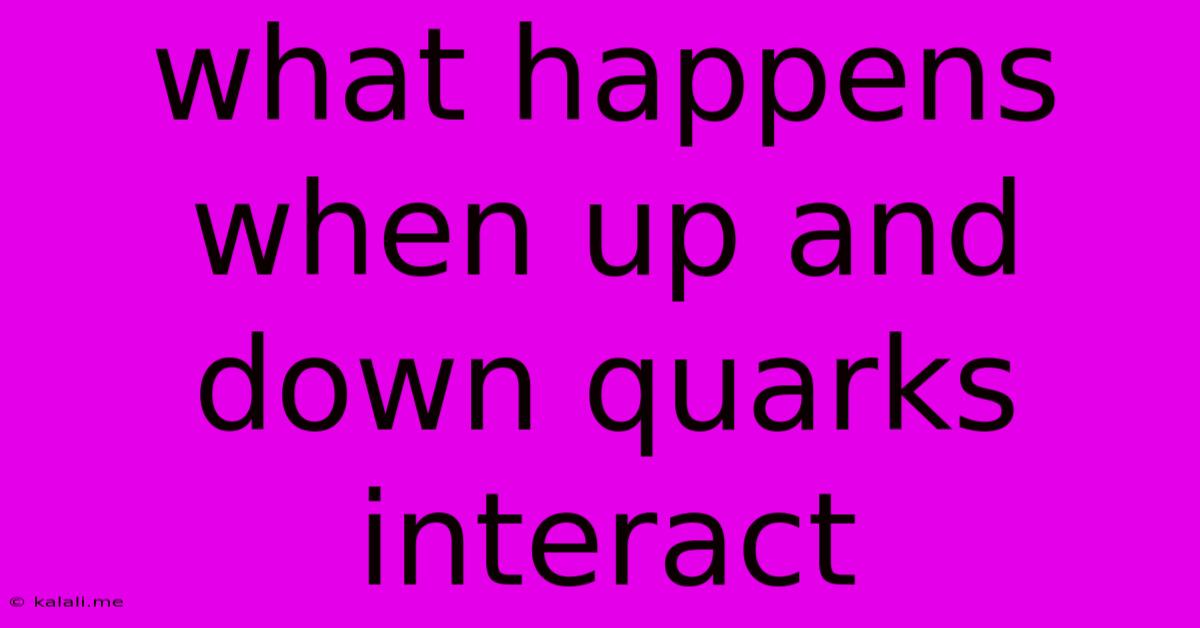What Happens When Up And Down Quarks Interact
Kalali
May 24, 2025 · 3 min read

Table of Contents
What Happens When Up and Down Quarks Interact? A Deep Dive into the Strong Force
This article explores the fascinating interactions between up and down quarks, the most common quarks in the universe, and the fundamental force governing their behavior: the strong nuclear force. Understanding these interactions is crucial to comprehending the structure of protons, neutrons, and ultimately, all atomic nuclei.
Meta Description: Delve into the intricate world of quark interactions. This article explains what happens when up and down quarks, the building blocks of matter, interact via the strong force, influencing the structure of protons, neutrons, and atomic nuclei.
The Players: Up and Down Quarks
Before diving into their interactions, let's briefly revisit the properties of up (u) and down (d) quarks. These are the lightest quarks, possessing fractional electric charges: +2/3 for the up quark and -1/3 for the down quark. They are also fundamental fermions, meaning they are elementary particles that obey Fermi-Dirac statistics. Crucially, they are subject to the strong force, mediated by gluons.
The Strong Force: The Glue that Binds
The strong force, described by Quantum Chromodynamics (QCD), is responsible for binding quarks together to form hadrons – particles like protons and neutrons. Unlike the familiar electromagnetic force, the strong force's strength increases with distance. This characteristic is known as asymptotic freedom: quarks are essentially free at very short distances, but the force becomes incredibly strong as they are pulled apart. This explains why we never observe free quarks in nature; they're always confined within hadrons.
Interactions: Gluon Exchange and Color Charge
The strong force is mediated by gluons, massless particles carrying the strong charge, often referred to as "color charge." Unlike electric charge, which comes in positive and negative, color charge exists in three varieties: red, green, and blue (and their anticolors: anti-red, anti-green, and anti-blue). Quarks carry one color charge, while antiquarks carry one anticolor charge.
When up and down quarks interact, they exchange gluons. This exchange alters the color charges of the participating quarks. For example, a red up quark might emit a red-antigreen gluon, transforming itself into a green up quark, while the gluon is absorbed by another quark, potentially changing its color as well. This continuous exchange of gluons creates a constant binding force, holding the quarks together within a hadron.
Forming Protons and Neutrons
The most familiar interaction between up and down quarks is their combination to form protons and neutrons, the fundamental constituents of atomic nuclei.
-
Proton: A proton consists of two up quarks and one down quark (uud). The combination of their color charges results in a colorless (white) overall state, a requirement for all observed hadrons.
-
Neutron: A neutron consists of one up quark and two down quarks (udd). Again, the combined color charge results in a colorless state.
The specific arrangement and interactions of the quarks within these particles determine their properties, including mass, spin, and magnetic moment. These properties are crucial in determining the behavior of atomic nuclei and the stability of matter.
Beyond Protons and Neutrons: Mesons and Other Hadrons
Up and down quarks also combine to form mesons, which are composed of a quark and an antiquark. Pions, for instance, are mesons consisting of an up quark and a down antiquark (or vice versa), playing a significant role in nuclear interactions. More complex hadrons involving multiple quarks also exist, although their formation and interactions are far more intricate and are actively researched.
Conclusion: A Universe Built on Quark Interactions
The interactions between up and down quarks, governed by the strong force and mediated by gluons, are fundamental to the structure of matter as we know it. Understanding these intricate processes is key to unlocking a deeper understanding of the universe at its most fundamental level. Further research into QCD and quark confinement continues to push the boundaries of our knowledge, revealing new insights into the behavior of these fundamental particles and the forces that govern them.
Latest Posts
Latest Posts
-
How To Remove A Stuck Screw
May 24, 2025
-
Getting Water Stains Out Of Wood
May 24, 2025
-
How To Throw A Grenade In Fallout 4
May 24, 2025
-
How Long Can Canned Cat Food Sit Out
May 24, 2025
-
Can I Cook Frozen Ground Beef
May 24, 2025
Related Post
Thank you for visiting our website which covers about What Happens When Up And Down Quarks Interact . We hope the information provided has been useful to you. Feel free to contact us if you have any questions or need further assistance. See you next time and don't miss to bookmark.